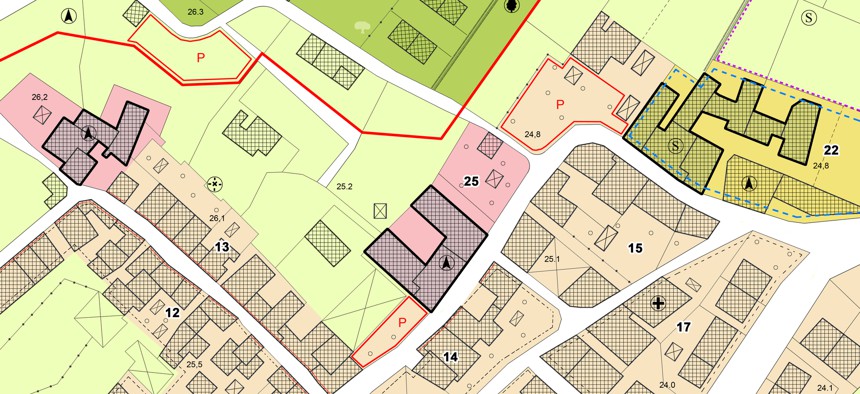Old Zoning Laws Share Blame For Housing Shortage

Francesco Scatena via Getty Images
A new report highlights zoning strategies that cities can adopt to bolster housing development equitably and sustainably, including overhauling single-family regulations.
Zoning codes established roughly a century ago were meant to protect residents from the impacts of industrial and commercial developments, but they were also used to enforce segregation. Those regulations have contributed in large part to the current housing shortage, and experts argue that it’s time for reforms.
As the nation confronts a severe housing crisis, the Biden administration is calling on local governments to revisit outdated zoning policies that slow development. A recent report from the Urban Land Institute highlights the zoning strategies cities are using to bolster housing development equitably and sustainably, including complete overhauls of single-family regulations and reductions of lot size minimums.
Roughly two-thirds of land zoned for housing in major U.S. cities only allows for single-family homes, the report notes, and in most cities apartments are banned in at least 70% of residential areas. Experts say that those regulations often hinder environmental and racial equity efforts.
“Single-family zoning policies were explicitly designed to exclude lower- and moderate-income households from the vast majority of U.S. residential areas,” said urban planning expert Nolan Gray in a recent Urban Land Institute webinar.
By allowing only single-family homes, so-called exclusionary zoning has priced lower-income households, which tend to be disproportionately households of color, out of certain neighborhoods. The practice has also reinforced racial segregation. These zoning policies, research has shown, reduces the quantity of affordable housing in neighborhoods with more amenities like parks and schools.
Single-family zoning also requires more land to house growing populations, which can lead to the development of green spaces and lead to more car-centric communities.
In confronting the problematic history and modern problems of single-family housing, some cities are choosing to do away with the regulations altogether.
In late 2018, the Minneapolis City Council adopted a plan that eliminated single-family housing, becoming the first major city to do so. The decision was part of the city’s long-term development plan, called Minneapolis 2040, and came as many households—especially households of color—could not afford housing costs, said Heather Worthington, consulting manager at the Center for Economic Inclusion.
Before Minneapolis implemented zoning regulations in 1927, the city was filled with multifamily homes, according to Worthington, who was part of the team that helped develop Minneapolis 2040. In the 1950s, there were, on average, five people living in single-family homes in Minneapolis. Over the next 70 years, that figure dropped to just two people per home.
“We don't so much have a housing problem as we have a tenancy and density problem,” Worthington said, adding that a city of only single-family homes is not economically sustainable for many residents.
Eliminating single-family zoning is a reform that’s gaining steam across the country. In 2020, Portland, Oregon, changed its residential zoning regulations to allow for more multifamily construction, and the following year California Gov. Gavin Newsom signed legislation that allows up to four units to be built on single-family lots.
Just last week, the county board in Arlington, Virginia, voted unanimously to allow building multifamily structures in areas that have traditionally been zoned for single-family homes. The decision came after years of contentious community debate.
Other increasingly popular reforms include eliminating parking minimums—an initiative included in Minneapolis 2040—and reducing minimum lot size requirements.
The latter is an effort that can reduce urban sprawl and make communities more walkable while also boosting housing stock. Gray pointed to Houston as a prime example of how this kind of reform can lead to more housing. In 1998, the city reduced minimum lot size requirements from 5,000 square feet to 1,400, making it possible to build three houses on a lot that previously would have hosted only one.
“This is, I think, a really valuable reform, particularly in suburban areas where the new development is still going to be single-family housing,” Gray said.
These reforms are not without significant barriers. Last year, a county judge halted Minneapolis’s zoning revamp, citing environmental concerns.
In other parts of the country, opponents to zoning reform worry about new developments disrupting neighborhood character, creating more traffic congestion and impacting property taxes, the report notes.
Updating regulations also forces officials to navigate constituents’ competing priorities. For instance, the report points to two surveys conducted in 2021. The first, facilitated by the National Association of Home Builders, found that more than two-thirds of homebuyers were concerned about their home’s environmental impact, and many said they wanted to live in a walkable community. Meanwhile, a Pew Research survey the same year found that 6 in 10 adults wanted to live in communities with houses that are large and far apart, even if it means schools and stores are several miles away.
But that’s not to say communities should settle for sticking with current zoning codes, the report notes.
“[E]ven if the majority of people really do prefer communities consistent with the typical suburban status quo,” the report said, “many others still prefer denser, more walkable development—and these people and families are underserved by current zoning and land use policies.”
Molly Bolan is the assistant editor for Route Fifty.
NEXT STORY: Nashville Attack Renews Calls for Assault Weapons Ban






